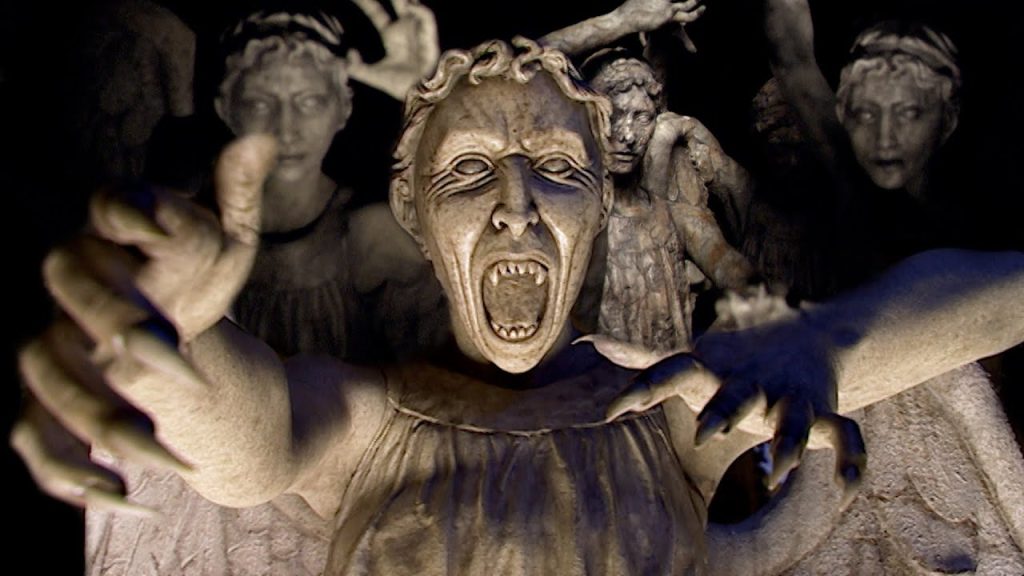For nearly 60 years, Doctor Who has thrilled audiences with adventures through time and space. From black and white beginnings to modern special effects, here are the 25 episodes that represent the show at its very best.
- “Blink” (2007)
Steven Moffat’s masterpiece introduced the terrifying Weeping Angels in an episode that barely features the Doctor. Carey Mulligan’s Sally Sparrow leads this innovative story that plays brilliantly with time and proves that Doctor Who can be genuinely scary. The phrase “Don’t Blink” entered popular culture and created one of the show’s most enduring monsters. - “Genesis of the Daleks” (1975)
Tom Baker’s Doctor faces his greatest moral dilemma when given the chance to prevent the creation of the Daleks. This six-part story explores the ethics of time travel while introducing Davros, the Daleks’ creator. The famous “Have I the right?” speech remains one of the show’s defining moments. - “Heaven Sent” (2015)
Peter Capaldi delivers a tour de force performance in this experimental episode where he’s essentially the only actor. The Doctor is trapped in a confession dial, repeatedly dying and recreating himself over billions of years. It’s a stunning examination of grief, persistence, and the Doctor’s character. - “The City of Death” (1979)
Written by Douglas Adams, this Paris-set adventure combines wit, style, and complexity. Tom Baker and Lalla Ward spark brilliantly in a story involving alien art thieves, multiple Mona Lisas, and time travel. It represents the show at its most sophisticated and entertaining. - “The Caves of Androzani” (1984)
Peter Davison’s final story is a dark thriller about corruption and sacrifice. The Doctor’s determination to save his companion while dying of poison showcases the character’s heroism. Often voted the best classic series story by fans. - “The Day of the Doctor” (2013)
The 50th anniversary special united David Tennant, Matt Smith, and John Hurt’s Doctors in a story that rewrote the show’s mythology. It balanced spectacle with emotional depth while celebrating the show’s history. - “The Talons of Weng-Chiang” (1977)
A Victorian-set story combining mystery, horror, and science fiction. Tom Baker’s Doctor channels Sherlock Holmes in this atmospheric tale of a time-traveling war criminal. - “The Empty Child/The Doctor Dances” (2005)
Steven Moffat’s first Who story introduced Captain Jack and created genuine horror with gas mask zombies in the London Blitz. The “Everybody lives!” ending showed how the show could balance darkness with joy. - “Pyramids of Mars” (1975)
Egyptian mythology meets science fiction as Tom Baker’s Doctor battles Sutekh, one of his most powerful enemies. The story perfectly balances horror and adventure while showing the consequences of time travel. - “The Girl in the Fireplace” (2006)
A beautiful meditation on time and love as the Doctor forms a relationship with Madame de Pompadour through various points in her life. Steven Moffat’s script combines romance, humor, and tragedy. - “Human Nature/The Family of Blood” (2007)
David Tennant gives a remarkable performance as the Doctor transformed into a human schoolteacher in 1913. The story explores the cost of being the Doctor and features one of the show’s most poignant endings. - “Midnight” (2008)
A claustrophobic thriller showing humanity at its worst when faced with the unknown. Russell T Davies’ script creates terror through suggestion and psychological horror. - “Silence in the Library/Forest of the Dead” (2008)
Introduction of River Song in a story combining horror and romance. The Vashta Nerada create genuine terror while the mystery of River’s identity begins. - “The Dæmons” (1971)
Jon Pertwee’s era peaked with this story mixing folklore, science fiction, and horror. The Master poses as a vicar in a story that influenced many later British folk horror works. - “Turn Left” (2008)
Catherine Tate shines in this parallel universe story showing what would happen if the Doctor had died. A dark examination of how crucial the Doctor is to Earth’s survival. - “Inferno” (1970)
Jon Pertwee’s Doctor visits a parallel universe where Britain is a fascist state. This grim alternate reality shows familiar characters in darker roles while tackling environmental themes. The story’s apocalyptic tone makes it uniquely haunting in Who history. - “The Robots of Death” (1977)
A classic murder mystery set on a sand miner with art deco-styled robots. The story combines Agatha Christie plotting with retro-futuristic design and explores the fear of artificial intelligence. - “Vincent and the Doctor” (2010)
A beautiful, emotional episode about depression, art, and legacy. The Doctor and Amy meet Vincent van Gogh in a story that handles mental health with remarkable sensitivity. The ending, where Vincent sees his future impact, remains one of the show’s most moving moments. - “The War Games” (1969)
Patrick Troughton’s epic final story revealed the Time Lords for the first time. This ten-part story about aliens kidnapping soldiers from Earth’s wars builds to a dramatic conclusion that changed the show forever. - “Listen” (2014)
Peter Capaldi’s Doctor becomes obsessed with the idea of perfect hiding and what might be under the bed. A psychological thriller that plays with fear itself and connects unexpectedly to the Doctor’s own childhood. - “Remembrance of the Daleks” (1988)
Sylvester McCoy’s Doctor returns to 1963 London in a story that cleverly ties into the show’s beginnings. It reinvented the Daleks while tackling racism and fascism. - “The Green Death” (1973)
Jon Pertwee’s era combined environmental messages with horror in this story about toxic waste creating giant maggots. Also notable for the departure of beloved companion Jo Grant. - “The Eleventh Hour” (2010)
Matt Smith’s debut perfectly introduces a new Doctor, companion, and era. The story establishes Smith’s quirky Doctor while creating a fairy tale atmosphere that would define his era. - “The Deadly Assassin” (1976)
A revolutionary story that took the Doctor to his home planet and redefined Time Lord society. Tom Baker’s Doctor investigates political conspiracy in a story that influenced much of the show’s later mythology. - “World Enough and Time/The Doctor Falls” (2017)
Peter Capaldi’s penultimate story brings back the original Cybermen in a dark tale about conversion and sacrifice. The story explores time dilation while providing a powerful meditation on what it means to be the Doctor.
These episodes showcase Doctor Who’s incredible range, from pure horror to comedy, from historical drama to futuristic science fiction. They demonstrate how the show has remained fresh and relevant through multiple decades and iterations, consistently finding new ways to tell compelling stories about time, space, and the human condition.
What makes these episodes particularly special is how they each push the boundaries of what Doctor Who can be, whether through innovative storytelling, powerful performances, or groundbreaking concepts. They prove that at its best, Doctor Who isn’t just a science fiction show but a vehicle for exploring complex ideas about morality, humanity, and the nature of heroism.
The list spans the entire history of the show, from its classic era to its modern incarnation, showing how Doctor Who has consistently evolved while maintaining its core values of intelligence, compassion, and adventure.



